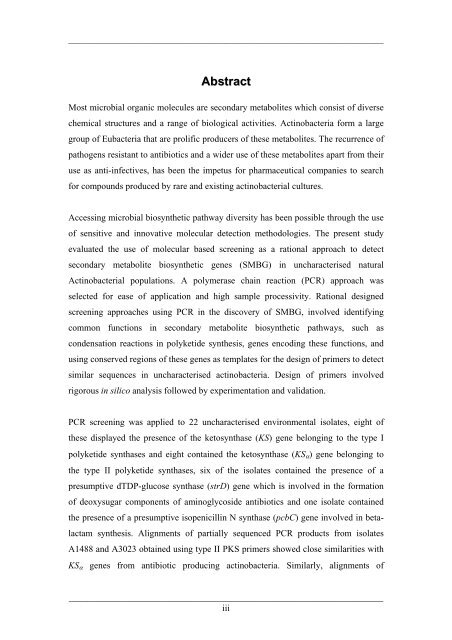Detection and Expression of Biosynthetic Genes in Actinobacteria ...
Detection and Expression of Biosynthetic Genes in Actinobacteria ...
Detection and Expression of Biosynthetic Genes in Actinobacteria ...
You also want an ePaper? Increase the reach of your titles
YUMPU automatically turns print PDFs into web optimized ePapers that Google loves.
___________________________________________________________________________________AbstractMost microbial organic molecules are secondary metabolites which consist <strong>of</strong> diversechemical structures <strong>and</strong> a range <strong>of</strong> biological activities. Act<strong>in</strong>obacteria form a largegroup <strong>of</strong> Eubacteria that are prolific producers <strong>of</strong> these metabolites. The recurrence <strong>of</strong>pathogens resistant to antibiotics <strong>and</strong> a wider use <strong>of</strong> these metabolites apart from theiruse as anti-<strong>in</strong>fectives, has been the impetus for pharmaceutical companies to searchfor compounds produced by rare <strong>and</strong> exist<strong>in</strong>g act<strong>in</strong>obacterial cultures.Access<strong>in</strong>g microbial biosynthetic pathway diversity has been possible through the use<strong>of</strong> sensitive <strong>and</strong> <strong>in</strong>novative molecular detection methodologies. The present studyevaluated the use <strong>of</strong> molecular based screen<strong>in</strong>g as a rational approach to detectsecondary metabolite biosynthetic genes (SMBG) <strong>in</strong> uncharacterised naturalAct<strong>in</strong>obacterial populations. A polymerase cha<strong>in</strong> reaction (PCR) approach wasselected for ease <strong>of</strong> application <strong>and</strong> high sample processivity. Rational designedscreen<strong>in</strong>g approaches us<strong>in</strong>g PCR <strong>in</strong> the discovery <strong>of</strong> SMBG, <strong>in</strong>volved identify<strong>in</strong>gcommon functions <strong>in</strong> secondary metabolite biosynthetic pathways, such ascondensation reactions <strong>in</strong> polyketide synthesis, genes encod<strong>in</strong>g these functions, <strong>and</strong>us<strong>in</strong>g conserved regions <strong>of</strong> these genes as templates for the design <strong>of</strong> primers to detectsimilar sequences <strong>in</strong> uncharacterised act<strong>in</strong>obacteria. Design <strong>of</strong> primers <strong>in</strong>volvedrigorous <strong>in</strong> silico analysis followed by experimentation <strong>and</strong> validation.PCR screen<strong>in</strong>g was applied to 22 uncharacterised environmental isolates, eight <strong>of</strong>these displayed the presence <strong>of</strong> the ketosynthase (KS) gene belong<strong>in</strong>g to the type Ipolyketide synthases <strong>and</strong> eight conta<strong>in</strong>ed the ketosynthase (KS α ) gene belong<strong>in</strong>g tothe type II polyketide synthases, six <strong>of</strong> the isolates conta<strong>in</strong>ed the presence <strong>of</strong> apresumptive dTDP-glucose synthase (strD) gene which is <strong>in</strong>volved <strong>in</strong> the formation<strong>of</strong> deoxysugar components <strong>of</strong> am<strong>in</strong>oglycoside antibiotics <strong>and</strong> one isolate conta<strong>in</strong>edthe presence <strong>of</strong> a presumptive isopenicill<strong>in</strong> N synthase (pcbC) gene <strong>in</strong>volved <strong>in</strong> betalactamsynthesis. Alignments <strong>of</strong> partially sequenced PCR products from isolatesA1488 <strong>and</strong> A3023 obta<strong>in</strong>ed us<strong>in</strong>g type II PKS primers showed close similarities withKS α genes from antibiotic produc<strong>in</strong>g act<strong>in</strong>obacteria. Similarly, alignments <strong>of</strong>_____________________________________________________________________iii















